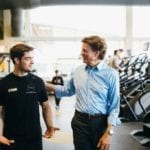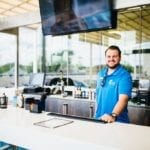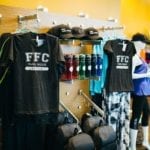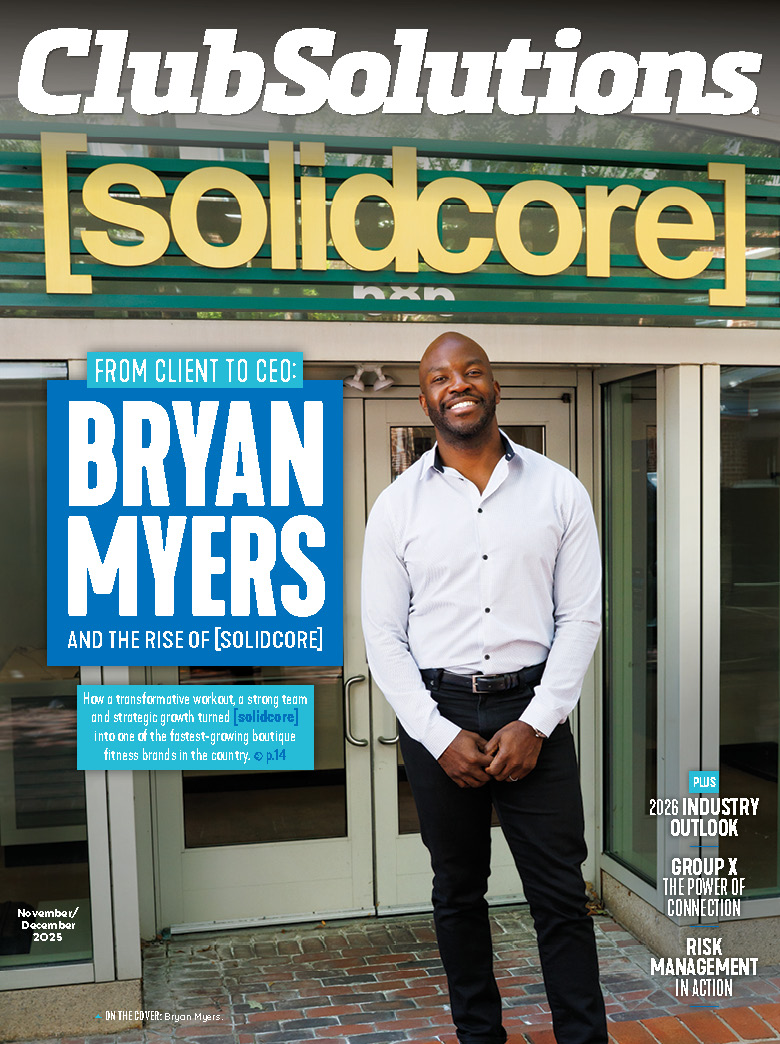How Gale Landers and Fitness Formula Clubs mastered the art of “the third place.”
In Ray Oldenburg’s 1989 book “The Great Good Place,” he discusses a concept called “the third place,” defined as “the social surroundings separate from the two usual social environments of home — first place — and the office — second place.”
According to Oldenburg, “the third place” includes environments such as cafés, public libraries, parks and clubs. Characterized by their accessibility, community feel and mix of both regulars and newcomers, Oldenburg theorizes these spaces are the “anchors” of communities, where more broad and creative interactions can be fostered.
In many regards, Fitness Formula Clubs (FFC) has mastered the concept of “the third place.” And there’s no better example of that than the company’s newest location — FFC Park Ridge — which opened in January 2017 and marked FFC’s 10th location in the greater Chicago area.
“We are known for our hub-and-spoke network of locations near trains, buses and subway commuter transportation centers, and this latest FFC edition is an ultra-convenient location 500 feet from the busy Metra train stop in Park Ridge, at the northwest corner of the city of Chicago,” explained Gale Landers, the CEO and founder of FFC. “It’s our first ‘built from the ground up’ facility. The intent was to create an energizing environment for fitness and wellness, but also be an inviting hangout with a community-building atmosphere and welcoming social spaces. A contemporary design incorporates masonry brick, metal panels, glass curtain walls and terracotta rainscreens.”
The 66,000-square-foot facility boasts a number of high-end amenities and unique activities for members to enjoy. Highlights include: four unique, dedicated spaces for group fitness; a Performance Training Center utilizing MYZONE heart rate monitors; a six-lane indoor pool and an outdoor pool with a sundeck and Splash Bar; an expansive Kids Club featuring an outdoor component; full-size basketball, volleyball and pickleball courts, and much more.

“We raised the bar to create an ultra-modern facility with major curb appeal located on a high-volume vehicular traffic artery,” continued Landers. “Most of the facility is elevated with parking at ground level below and around the facility. Building from scratch allowed for high ceilings and massive loads of natural light, which we all know members love.”
FFC’s newest location doesn’t just offer a “wow” factor in terms of its size and design — creating a high-end customer experience was also a main focus, which the company accomplished by equipping FFC Park Ridge with high-quality, trained staff from the get-go.
“It’s always about the staff,” said Landers. “You can have the most wonderful facility, but it comes down to the challenge of being fully staffed prior to opening, having them fully trained and ready to deliver your brand promise that you are known for and have been pre-selling for several months. We open each new location with as much FFC DNA as possible. This means promoting or transferring as many current staff at our existing locations to a new location as possible. They know our systems, have experience with the FFC core values and mission, and know the ‘FFC Way.’ This is where we often have a home court advantage. By staying regionally based to the Chicago metro market, we can be nimble, flexible and benefit from economies of scale in these areas.”
FFC Park Ridge is a shining example of all that makes FFC successful — a beautiful facility, high-end amenities, great staff, and a mix of functional and social spaces. But, the keys to the company’s success go much deeper than what’s seen on the surface. Ultimately, success comes down to the great experiences FFC provides to both members and staff, experiences that are FFC’s true differentiators.
Fitness Formula Clubs’ Customer Experience
At FFC, ensuring members have a great experience is the responsibility of every employee, from housekeeping to the senior leadership team.
Company wide, FFC has recently enhanced the customer experience in a number of ways, with the goal of providing more “social capital” to members. Landers defined “social capital” as, “the feeling and awareness of having more options and conveniences via our additional locations and amenities that we have added the past few years.”
According to Landers, the concept of “walkable urbanism” plays a role in this social capital experience. “Urban residents often have a lack of space indoors,” he explained. “Residents want to be able to walk just a few blocks and have the opportunity to go to a cool place, escape and have a home away from home. In part, to meet that need, we added outdoor swimming pools and/or sundecks at our last four new locations. These receive high use and create a much higher level of value to our members.”
In addition to being conveniently located, another important aspect to FFC’s customer experience includes ensuring each club is equipped with the latest and greatest technologies, including reliable WiFi and cable. And according to Greg Cibura, the chief technology officer, this too plays into the concept of FFC as a “third place” for members.
“We want to make FFC a ‘third place,’ which means it has to be comfortable, it has to be clean, it has to be convenient, the level of customer service has to be exceptionally high,” said Cibura. “Whether they’re going to workout, meet people at the café or they’re going to take a business call, the technology at the club has to be up to speed, up to standards, in order to accommodate our users, especially because most of our clubs are in the city. People with busy lives need to be able to rely on us for their ‘third place,’ so to speak, and technology plays a little role in that.”

To further increase the customer experience, each FFC location has its own unique spin, boasting programs and offerings catered specifically to the neighborhood it resides within.
“We like to think of ourselves as a network of neighborhood clubs, and not necessarily a chain of gyms,” explained Jeff Riney, the vice president of operations for FFC. “In saying that, we imply we understand the South Loop neighborhood is very different from the Gold Coast neighborhood, which is very different from the East Lakeview neighborhood. Even though there are things that are a common thread in terms of how we service our members and design elements, we also want the clubs to be unique in their own way.”
The focus on social capital, technology and “walkable urbanism” all enhance the customer experience and further differentiate FFC — positioning the brand as high-quality at a mid-price. That, and the fact that as a company, FFC is devoted to its mission to enhance members’ lives and improve their overall health and well-being.
This mission — also known as the “FFC Way” — is showcased in FFC’s member integration process. Each new member is provided with not just one, but four complimentary one-hour sessions with a personal trainer, Pilates instructor, registered dietitian or other fitness professional who aligns with their overall health and wellness goals. In addition, if they average three visits a week in their first 90 days, their entire enrollment fee (averaging around $275) will be credited to their club account in the form of FFC Bucks that can be used toward in-gym services.
“As a usage-based model, we want members to get involved so they actually stay,” explained Riney. “We feel [the member integration process] helps differentiate us from the gym down the street, and not necessarily be a commodity. We all know 15-pound dumbbells weigh the same everywhere — we don’t want to be the place that’s bigger and has more of them, we want to be the place that actually shows them how to use them and gets members excited to come in and do it more often.”
To further ensure new members are integrated properly, each week FFC hosts a new member presentation meeting led by every location’s member experience manager, along with the general manager, fitness director and Group X manager. During the meeting the group goes through a list of new members that joined over the last seven days, describing their goals and programs they’re interested in. Collectively, they ensure the onboarding strategy is personalized for each member’s success.
The benefits of this member integration strategy are three-fold. For one, member retention has improved. As an example, Riney explained the more complimentary sessions new members take advantage of, the greater the likelihood the customer will still be a member two years down the road.
Second, FFC has broken every revenue record over the past few years for ancillary services, including personal training, Pilates, nutrition and more — thanks in part to the four complimentary sessions. “Part of it definitely has to do with the fact more and more people are getting in front of the trainers in this critical early stage of their membership,” said Riney.
Finally, member engagement and positive customer feedback have risen, which FFC measures through the customer survey tool Medallia.

According to Riney, a key to ensuring the member integration strategy is successful lies in the creation of the member experience manager position, which FFC developed just last year. “We felt that for a long time we were focusing on retention, but we weren’t really doing anything different about it,” he recalled. “The ‘aha’ moment was in late 2015 or early 2016, when we realized that member retention was the secondary responsibility of every single person in the company, but it was the primary responsibility of nobody. We felt like we weren’t going to move the needle on retention until we actually had somebody in each club whose primary job, every day, was doing things to drive member retention, both proactively and reactively.”
In addition to leading the new member presentation meetings, the member experience managers are responsible for handling cancellations, the front desk, Kids Clubs and other hospitality touch points for members. Today, each of FFC’s 10 locations has its own member experience manager.
“They’re managing the X Factor, non-commodity aspects of our business,” said Riney. “We had to hire a different level of experience, a different level of talent — it was certainly an investment in people — but we made a commitment by increasing the payroll for those new roles, and so far it’s showing it has paid off.”
Fitness Formula Clubs’ Employee Experience
In addition to creating a “third place” for members, FFC strives to do the same for staff in a variety of ways.
“Whether it’s an open door policy, whether it’s supporting staff inside or outside of work, providing career paths for people and hiring from within, the workplace environment here is an exceptional one, just like the exceptional environment we provide for members,” said Cibura.
In fact, FFC has even drawn inspiration from the new member integration strategy, and now uses a similar strategy to integrate new employees. Each week, the senior leadership team hosts a new employee orientation, and also requires employees to go through the same sessions members are offered complimentary during the onboarding process.
“The four new training sessions for members, we’re now doing that for employees,” explained Riney. “So any new employee we hire at FFC, whether they’re customer service, housekeeping, or a trainer or membership director, they’re going to go through a training session, a Pilates session, a full tour with a sales rep, a dietitian consultation — they go through every one of the services our members could possibly go through, so they really understand what it is we do, versus learning in a classroom setting.”
Another great example of FFC’s dedication to employees is FFC University, the company’s in-house education program, which provides seminars employees can take on leadership, accounting and more. FFC also shows support and appreciation for employees by recognizing milestones and offering rewards and tuition reimbursement.
According to Jon Baraglia, the senior director of fitness for FFC, this focus on employee engagement and education has a dual benefit. In addition to making employees feel valued, it also feeds directly into FFC’s member experience. “We know that an educated employee is able to provide a better experience to our customers,” he said. “Your employees are everything. Finding the right, talented people and then hanging onto them is what makes the member experience great and what makes the environment great.”

Of course, without leadership, these benefits would not be possible, which is why fostering a strong core leadership group and offering upward mobility are also key factors to FFC’s employee experience.
With this in mind, FFC develops leaders in a variety of ways outside of FFC University, including sending senior leaders to learning conferences and recognizing and rewarding excellence. “Leadership development is like investing,” said Landers. “The more the asset compounds, the result is growth over time.”
To pursue excellence, Landers explained FFC’s leadership team uses a concept called “six by six,” where leaders take charge of six key initiatives they must tackle every six weeks.
“These are items that collectively move the company forward and are aligned with our strategic initiatives we set annually,” explained Landers. “A month is too short, and a quarter is too long. They provide a basis for brief conversations [regularly] and lend direction to prioritizing time and direction. The senior team does the same thing with their direct reports.”
Thanks to these strategies and more — and with FFC Park Ridge as a shiny, new example — FFC continues to solidify itself as a leader in the health and fitness industry, with innovation constantly at the forefront.
“We have pushed toward further differentiating FFC by creating as large of an overwhelming value proposition as possible,” said Landers. “High-quality at a mid-price.”
Stay ahead in the fitness industry with exclusive updates!
Rachel Zabonick-Chonko is the editor-in-chief of Club Solutions Magazine. She can be reached at rachel@peakemedia.com.




















![From Client to CEO: Bryan Myers and the Rise of [solidcore]](https://d296qbqev3kq48.cloudfront.net/wp-content/uploads/2025/11/06151333/CS-NovDec25-CoverStory-3-350x250.jpg)






